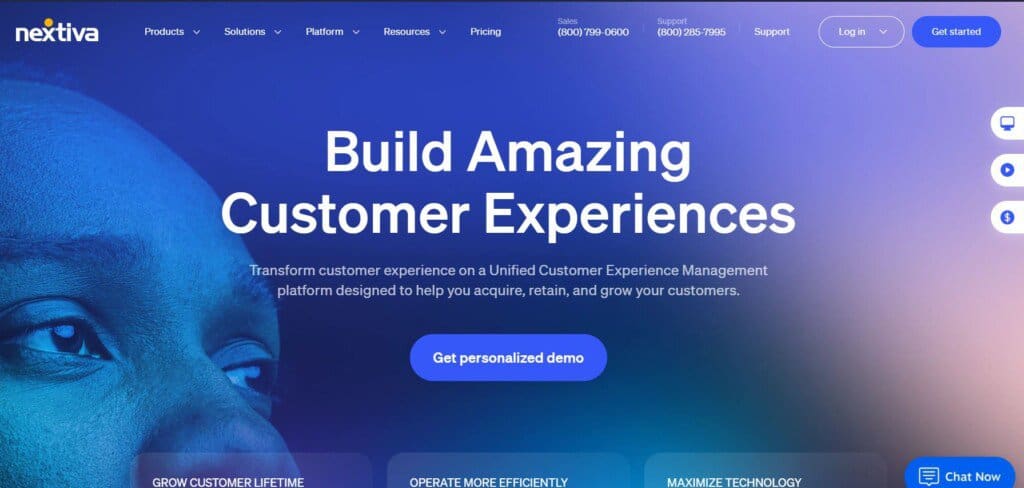- Main Differences Between Ringcentral And Nextiva
- Similarities Between RingCentral and Nextiva
- What is RingCentral?
- What is Nextiva?
- Some Key Nextiva Features Include:
- RingCentral vs Nextiva: Pricing
- RingCentral vs Nextiva: Pros and Cons
- RingCentral Pros
- RingCentral Cons
- Nextiva Pros
- Nextiva Cons
- RingCentral vs Nextiva: Alternatives
- Which Platform To Choose
Last Updated on April 14, 2025 by Ewen Finser
These two VOIP platforms are well-known for providing comprehensive business communication solutions.
Both support a huge range of features including voice calling, video calling, and team messaging.
However, there are differences in terms of pricing, integrations with third-party tools and their respective advanced features.
Main Differences Between Ringcentral And Nextiva
Feature | RingCentral | Nextiva |
Call Management | Uses multi-stage call menus and AI-powered ACDs to route and automate calls. | Includes AI-driven call routing, preconfigured rules, and IVR options for self-service |
Video Conferencing | Supports fifty minute meetings for one hundred participants on the free plan. 24 hour meetings for up to 200 people on paid plan). | Unlimited HD video conferencing for up to 250 users. Record and store meetings for 90 days (paid plan). |
AI Features | AI-powered insights, including meeting summaries, keywords used, and meeting transcripts. | Contact Center AI (CCAI) tools for intelligent automation, advanced analytics and natural language processing (NLP). |
Integrations | Supports +400 integrations with CRM tools like Hubspot and Zendesk. | Integrates with popular business apps like Zoho, Salesforce, and Microsoft Teams |
Pricing | Starts at $20/user/month, assuming users pay annually. | Starts at $20/user/month, assuming users pay annually. Advanced features are available with their plans. |
I happen to like Talkroute as the better fit for small businesses. I don't need extra telephony equipment and it's easy to setup (compared to many VOIP services). It's also perfect if your internet service is uneven OR can't handle a full-on VOIP install. It's also cheaper than most peers I looked it.
Similarities Between RingCentral and Nextiva

Unified Communication
Both RingCentral and Nextiva support common business phone features like voice/video calls, SMS, and team messaging from a centralized app.
Mobile Apps
There are iOS and Android apps available for both platforms allowing workers to connect from any location.
API Integration
Nextiva has committed to ensuring that all interface elements are API-driven, making the platform extremely customizable. RingCentral’s API also has extensive integration support for features like business SMS and team messaging.
Basic Pricing Plan
Both RingCentral and Nextiva charge $20 per user, per month for the lowest pricing tier, assuming subscribers pay annually. If paying monthly, Nextiva’s ‘Digital’ plan costs $5 less ($25), than RingCentral’s ‘Core’ plan ($30).
Free Trials
RingCentral offers a free 14-day trial for 1-20 virtual phone lines. Nextiva offers different free trials, depending on the specific product e.g. NextivaONE is 14 days.
What is RingCentral?
RingCentral is arguably one of the most popular enterprise-level business communications platforms, due to supporting many advanced call management functions.
Crucial RingCentral features include:

Multi-stage IVR
Like other business VOIP platforms, RingCentral supports playing a custom greeting to callers. However, users can then set up multiple voice-response options. The idea here is to reduce wait time, as callers can be directed to automated options, like paying for parking charges by entering their card information using the keypad.
Flexible Integrations
Of all the VOIP platforms I’ve encountered, RingCentral by far supports the most number of integrations. Currently this numbers at over 400 tools that work automatically with the platform. These include popular tools like HubSpot, Salesforce, and Zendesk.
Video Meetings
RingCentral offers a free plan, which subscribers can use to hold fifty-minute meetings for up to one hundred people. If you pay $10 per user per month for a ‘Video Pro+’ plan, there’s no time limit and meetings can hold up to 200 people.
What is Nextiva?
This versatile VOIP platform combines both communication tools with customer experience management features. This makes it perfect for businesses that need detailed customer insights.

Some Key Nextiva Features Include:
Conversational AI
Nextiva uses NLP (natural language processing), powered by Google Dialogflow and IBM Watson to offer open-ended prompts. This can make for a much happier customer experience compared to navigating multiple menus.
Simultaneous Ring
As the name suggests, this feature lets users ring multiple numbers at the same time. You can list up to ten additional numbers/extensions. This can be helpful if workers have multiple devices e.g. a desk phone and a cell phone.
Unlimited Video Meetings
Nextiva ‘Core’ plan subscribers, as well as those on higher-paid tiers can hold video meetings of any length for up to 250 people.
RingCentral vs Nextiva: Pricing
Both RingCentral and Nextiva offer discounts to customers who pay annually. The prices shown below are for monthly subscriptions.
Plan | RingCentral (Monthly) | Nextiva (Monthly) |
Basic/Starter | $30/user | $25/user |
Mid-tier/Standard | $35/user | $36/user |
Premium/Enterprise | $45/user | $50/user |
RingCentral vs Nextiva: Pros and Cons

RingCentral Pros
No Extra Cost for Toll-free Numbers
New subscribers to RingCentral are asked to choose a virtual number. This can be a toll-free (e.g. 800 number) at no extra cost.
Superior Video Conferencing
While Nextiva requires users to pay $30 per user per month for the privilege of video meetings, RingCentral’s free plan supports 50-minute meetings for up to 100 people on its free plan. Boost this to unlimited meetings for 200 participants with a Video Pro+ subscription.
RingCentral Cons
Limited Support for Faxing
While this probably isn’t an issue for many companies, if you work in certain sectors like healthcare faxes are a reality of day-to-day business. RingCentral’s “Core” plan doesn’t support this, though the ‘Advanced’ and ‘Ultra’ tiers do have internet faxing features.
Higher Cost Starter Plan
RingCentral’s basic ‘Core’ plan is more expensive than Nextiva for users who pay monthly, though they both come to $20 per month for annual subscriptions. RingCentral’s basic plan also includes more features than Nextiva’s e.g. video meetings.
Nextiva Pros
Affordable Entry-level Pricing
Nextiva’s basic “Digital” plan costs $5 less per user relative to RingCentral for monthly subscriptions. As I mentioned above however, it doesn’t have all the same features like Business SMS.
Strong Focus on Customer Experience
The platform’s emphasis on integrated analytics means that it’s ideal for sectors that require detailed call information like telesales.
Nextiva Cons
Advanced Features Require Higher-paid Plans
Having praised Nextiva’s integration abilities with popular tools, if you want to use it with Microsoft Teams, you’ll need to pay $50 per user for an ‘Engage’ subscription. The same holds true for other features like toll-free numbers and ACD callback.
Limited SMS Features
Lower-paid plans also have limited business SMS features. Nextiva’s basic ‘Digital’ subscription doesn’t support SMS at all. If you want to send messages to multiple team members, you’ll need a ‘Message Pro’ subscription, which starts at $10 per user, per month.
RingCentral vs Nextiva: Alternatives
If you’re running a small organization and just need basic business communications, Talkroute might be a better option.
It supports essential features like call routing, business SMS, and voicemail management (with transcription). Its basic pricing plan starts at $19 per month for a single user and mailbox. Additional users are just $5 each, no matter the pricing tier.
If your organization relies heavily on business SMS, Grasshopper supports text from both local and toll-free numbers. Plans start from $14 per month (billed annually) and support unlimited texting.
Although faxing is less popular these days, if you work in a sector that still uses it, then consider subscribing to Ooma. This business VOIP platform supports integrating fax machines with Ooma’s devices. Subscribers to the ‘Essentials’ plan can also get a virtual fax number at no additional cost. Prices start at $19.95 per user/per month.
I happen to like Talkroute as the better fit for small businesses. I don't need extra telephony equipment and it's easy to setup (compared to many VOIP services). It's also perfect if your internet service is uneven OR can't handle a full-on VOIP install. It's also cheaper than most peers I looked it.
Which Platform To Choose
RingCentral is undoubtedly the best business VOIP solution if you need extensive integration for third-party tools. It’s also better at managing business SMS, call management, and video conferencing.
Nextiva is perfect for organizations that value customer experience, as it has tools like Caller AI. It’s also a good option for businesses that need advanced caller analytics.
Talkroute is the best choice for SMBs that prefer simplicity over super-advanced features. As it uses traditional PSTN lines, it can also work in areas with limited Internet coverage.
If you’re on a budget but still need unlimited business SMS, Grasshopper is a good choice. Organizations that need to send and receive traditional or virtual faxes will find Ooma offers the best integration options.


